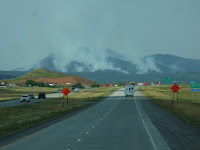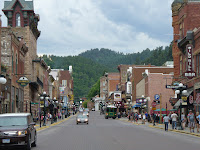
The Vore Buffalo Jump located near Beulah, WY is the site of a natural sink hole used by various Plains Indian tribes to hunt and trap bison. Used from about 1500 to 1800, and uncovered when construction began on I-90, the layers of well preserved bones and artifacts have given archaeologists a unique view of changes in hunting practices over the centuries. Uncovered remains indicate that thousands of buffalo were harvested at this site alone.
Exhibits and interpreters explain how the tribes would come together each fall and herd groups of about 200 buffalo toward the jump site. At the last minute a stampede was initiated and the buffalo fell to their death. The hunters then would descend into the sink hole and harvest meat, skins, bone...whatever they needed to prepare to survive the coming winter. This method of hunting on foot appears to have declined once horses and firearms became available.













